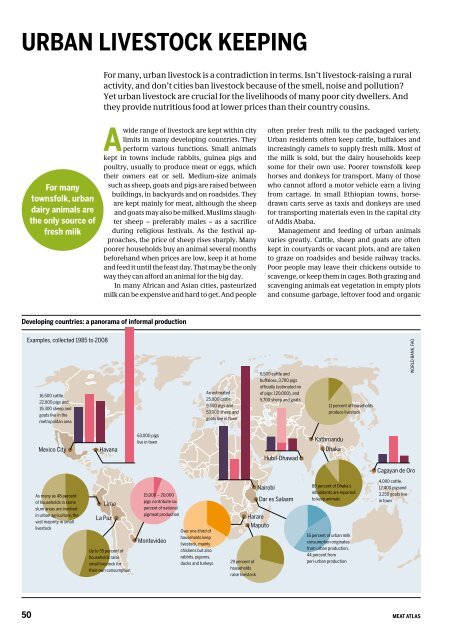URBAN LIVESTOCK KEEPINGFor many, urban livestock is a contradiction in terms. Isn’t livestock-raising a ruralactivity, and don’t cities ban livestock because of the smell, noise and pollution?Yet urban livestock are crucial for the livelihoods of many poor city dwellers. Andthey provide nutritious food at lower prices than their country cousins.For manytownsfolk, urbandairy animals arethe only source offresh milkAwide range of livestock are kept within citylimits in many developing countries. Theyperform various functions. Small animalskept in towns include rabbits, guinea pigs andpoultry, usually to produce meat or eggs, whichtheir owners eat or sell. Medium-size animalssuch as sheep, goats and pigs are raised betweenbuildings, in backyards and on roadsides. Theyare kept mainly for meat, although the sheepand goats may also be milked. Muslims slaughtersheep – preferably males – as a sacrificeduring religious festivals. As the festival approaches,the price of sheep rises sharply. Manypoorer households buy an animal several monthsbeforehand when prices are low, keep it at homeand feed it until the feast day. That may be the onlyway they can afford an animal for the big day.In many African and Asian cities, pasteurizedmilk can be expensive and hard to get. And peopleoften prefer fresh milk to the packaged variety.Urban residents often keep cattle, buffaloes andincreasingly camels to supply fresh milk. Most ofthe milk is sold, but the dairy households keepsome for their own use. Poorer townsfolk keephorses and donkeys for transport. Many of thosewho cannot afford a motor vehicle earn a livingfrom cartage. In small Ethiopian towns, horsedrawncarts serve as taxis and donkeys are usedfor transporting materials even in the capital cityof Addis Ababa.Management and feeding of urban animalsvaries greatly. Cattle, sheep and goats are oftenkept in courtyards or vacant plots, and are takento graze on roadsides and beside railway tracks.Poor people may leave their chickens outside toscavenge, or keep them in cages. Both grazing andscavenging animals eat vegetation in empty plotsand consume garbage, leftover food and organicDeveloping countries: a panorama of informal productionExamples, collected 1985 to 200816,500 cattle,22,600 pigs and19,300 sheep andgoats live in themetropolitan areaAn estimated25,000 cattle,9,500 pigs and53,000 sheep andgoats live in town6,500 cattle andbuffaloes, 3,700 pigsofficially (estimated noof pigs: 120,000), and5,700 sheep and goats11 percent of householdsproduce livestockWORLD BANK, FAO63,000 pigslive in townMexico CityHavanaKathmanduDhakaHubil-DhawadCagayan de OroAs many as 48 percentof households in someslum areas are involvedin urban agriculture, thevast majority in smalllivestockLimaLa PazUp to 55 percent ofhouseholds raisesmall livestock fortheir own consumption15,000 – 20,000pigs contribute sixpercent of nationalpigmeat productionMontevideoOver one-third ofhouseholds keeplivestock, mainlychickens but alsorabbits, pigeons,ducks and turkeys29 percent ofhouseholdsraise livestockNairobiHarareMaputoDar es Salaam80 percent of Dhaka’sinhabitants are reportedto keep animals16 percent of urban milkconsumption originatesfrom urban production,44 percent fromperi-urban production4,000 cattle,12,400 pigsand3,250 goats livein town50MEAT ATLAS
Developed countries: livestock coming back to townResults of a survey in the USA, 2011, 134 respondentsreason for raising livestock, percent12134232frequency of meat eating, percent441244201510impact on neighbours, number of respondentscommunity buildinganimal soundsmultigenerationalengagementeducationnoise nuisancesmellfear of injury/diseasePLUCKANDFEATHER.COM5better food sourceeducationcommunity buildingcostecologyculturesince starting livestock keepingless meatmoresame as before0positivenegative“waste” in the streets. If people keep broilers ordairy cows to supply the formal or informal market,they often buy feed supplements or mix themat home. They may also purchase hay, straw orfresh lucerne (alfalfa) and bring it into town, oftenby donkey.How important are urban livestock? It is hardto tell, as it is mainly informal and often illegal. Inthe Republic of Congo, a study found that aboutone-third of the people in Brazzaville were engagedin urban agriculture. Nine percent keptlivestock, mostly poultry. In the 1980s in Kenya,almost 70 percent of the households in Kibera, thebiggest slum in Nairobi, were practising urbanagriculture. That included an unknown numberof animal keepers. Twenty years later, the houseshad become so densely packed that it was almostimpossible to grow crops. But poultry and pigs arestill kept even in very congested urban areas. Animalstake up less space than crops.Not only the poor keep livestock in cities. InAddis Ababa, the households with cattle have nineanimals on average. Many can even afford to hirelabour for grazing, feeding and other care. Thepoorer livestock keepers tend to have poultry, andkeep a few sheep or goats. For these families, consumingtheir own animals on special occasionsmay be their only chance to eat meat. This is importantnot only for their diets, but also for theirreligious beliefs and self-esteem.Interest in livestock keeping in urban areastypically increases when times are hard. In Kampala,Uganda, the number of urban animals rosesharply during political upheavals. In Central Asia,more urban residents started keeping animals afterthe Soviet Union collapsed. Livestock tend tobecome less important when economies recoverand household incomes increase. This also occurredin European cities after the Second WorldWar. Therefore, a rise in urban livestock may bea sign of economic distress and political crisis. Atsuch times, keeping livestock – and indeed urbanagriculture in general – is a survival mechanism,primarily to provide food.MEAT ATLASIn the developed world, livestock keeping inurban areas, in the broad sense of the term, includesbeekeeping, fish farming and using earthwormsto produce compost. Its main purpose is togenerate income and provide a meaningful occupation.According to social researchers, it can helpboost the self-confidence and desire to learn andwork of young people living in the slums of big cities,such as New York.However, when animals and people live closetogether in cities, the risk of disease increases. Thisis by no means limited to avian flu. Many humandiseases, such as influenza, smallpox, plague,measles, tuberculosis, and cholera, evolvedthrough the interaction of people and livestockover the last 10,000 years. Good veterinary care reducesthe incidence of animal disease and the riskof transmission to humans.Why should it be allowed to keep livestockin cities? During economic crises, it is an importantcoping strategy. It turns waste into aresource and produces valuable meat, milkand eggs. It raises the standing and self-esteemof poor people in societies in which animals playan important cultural role. And it is crucial for thesocial security of vulnerable groups such as the elderlyor households headed by women.Rural and urban populationPopulation in developed and developing world, millionsrural, developingurban, developingrural, developedurban, developed5,0004,0003,0002,5002,0001,5001,00050001950 1960 1970 1980 1990 2000 2010 2020 2030WORLD BANK, FAOKept onroadsides, unusedland and backyards,animals incurfew costs51


